Zodiac constellations are constellations that lie along the plane of the ecliptic. The ecliptic, or the apparent path of the Sun, is defined by the circular path of the Sun across the sky, as seen from Earth. In other words, the Sun appears to pass through these constellations over the course of a year.
The passage of the Sun through the zodiac is a cycle that was used by ancient cultures to determine the time of year. Most of the planets in the solar system have orbits that take them near the ecliptic plane, within about 8 degrees above or below.
How many zodiac constellations are there?
There are 12 constellations in the zodiac family. They can all be seen along the ecliptic. They are: Aries, Taurus, Gemini, Cancer, Leo, Virgo, Libra, Scorpius, Sagittarius, Capricornus, Aquarius and Pisces.
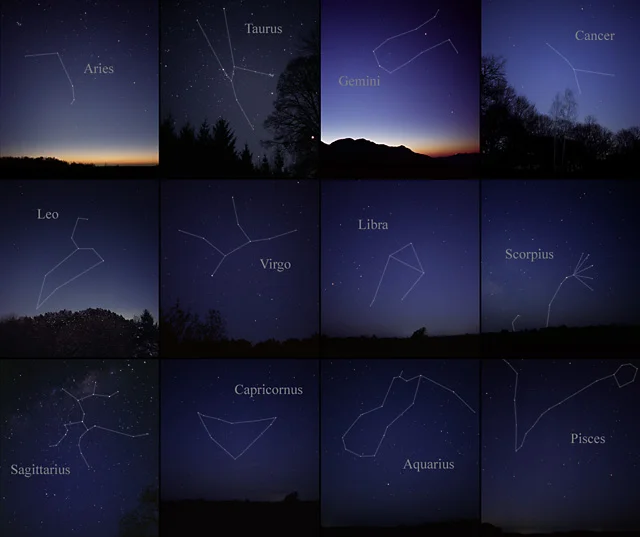
Zodiac constellations, image: Till Credner (CC BY-SA 4.0)
The Sun also passes through Ophiuchus, a constellation that has traditionally not been part of the zodiac family. It belongs to the Hercules family.
The northern zodiac constellations – Pisces, Aries, Taurus, Gemini, Cancer and Leo – are located in the eastern celestial hemisphere, while the southern – Virgo, Libra, Scorpius, Sagittarius, Capricornus and Aquarius – are found in the west.
The word zodiac comes from the Greek ζῳδιακός (zōidiakos), meaning the “circle of animals.” The Latin term zōdiacus was derived from the Greek, and the Greek term comes from the word ζῴδιον (zōdion), which is the diminutive of ζῷον (zōon), or animal. Seven of the constellations found along the ecliptic represent animals, as they did in Greek and Roman times: Aries (the Ram), Taurus (the Bull), Cancer (the Crab), Leo (the Lion), Scorpius (the Scorpion), Capricornus (the Goat), and Pisces (the Fish).
Today, the term zodiac is mostly associated with astrology, with the 12 signs of the western zodiac corresponding to the 12 constellations seen along the ecliptic. The so-called cardinal signs (Aries, Cancer, Libra and Capricorn) mark the beginning of the four seasons, i.e. the Sun is said to enter these signs on the first days of spring, summer, autumn and winter respectively. This may have been somewhat true in antiquity, but due to the Earth’s axial precession, the vernal and autumnal equinoxes (known as the First Point of Aries and First Point of Libra) have since moved to Pisces and Virgo. The equinoxes are the points where the ecliptic and the celestial equator intersect, and the Sun appears directly above the equator twice a year (on March 19-21 and September 21-24).
The largest of the 12 zodiac constellations is Virgo, which covers 1294.43 square degrees of the southern night sky. Virgo is also the second largest of all 88 constellations, only slightly smaller than Hydra.
Covering an area of 979.85 square degrees, Aquarius is the second largest zodiac constellation and the 10th largest constellation in the sky. Also located in the southern celestial hemisphere, Aquarius represents Ganymede, the cup bearer to the Olympian gods in Greek mythology.
Leo, the third largest zodiac constellation, occupies an area of 946.96 square degrees of the northern sky. It represents the Nemean lion, a mythical monster defeated by Heracles as part of his 12 labours.
Pisces comes in fourth with 889.417 square degrees, followed by Sagittarius (867.43 square degrees) and Taurus (797.25 square degrees). Libra (538.05), Gemini (513.76), Cancer (505.87) and Scorpius (496.78) cover areas similar in size and on the smaller end of the scale. Aries stretches across 441.39 square degrees while Capricornus, the smallest of the 12 zodiac constellations, covers 413.95 square degrees of the southern sky.
In terms of brightness, several of the 12 constellations contain some of the brightest stars in the sky. Aldebaran, the brightest star in Taurus, is the 14th brightest of all stars, followed by Spica, the brightest star in Virgo and 15th brightest star in the sky, Antares, the bright red supergiant in Scorpius and 16th brightest star, Pollux in Gemini, the 17th brightest of all stars, and Regulus in Leo, which comes in 21st overall.
Today, zodiac constellations are most commonly brought up in the context of western astrology, as the 12 constellations correspond to the 12 signs of the zodiac.
The problem with linking the astronomical constellations with astrology to give the latter a more “scientific” foundation is a simple one: the constellations themselves aren’t real. They are groups of stars that appear to be close to each other, arbitrarily named after different objects, animals, or figures from mythology by human observers at some point in history.
Constellations make a two-dimensional map of the sky used for orientation, to make it easier for astronomers to find objects and explain their location and for navigators to use stars to determine their position. The universe itself, on the other hand, isn’t flat and doesn’t revolve around our planet, which is what makes these groupings of stars arbitrary. While even Carl Gustav Jung said that astrology holds some value as a theory of the personality, and it can use the scientific approach, it is in itself not based on any kind of science.
How to find zodiac constellations
The constellations of the zodiac are fairly easy to find because they either contain a conspicuous asterism or are located near one. Because the Sun appears to travel through these constellations, they do not rise in the night sky at certain times of the year, but are visible at other times. For instance, the Sun appears to pass through Taurus from mid-May to mid- to late June and the constellation does not rise above the horizon during this period. When Taurus is at opposition to the Sun in late November and early December, it stays in the sky the entire night.
Taurus and Gemini
The zodiac constellations best seen in the winter are Taurus and Gemini. The constellations’ brightest stars, Aldebaran and Pollux, are part of the Winter Circle, a large hexagon asterism formed by six first-magnitude stars. Both constellations are easily found using the bright stars of Orion.
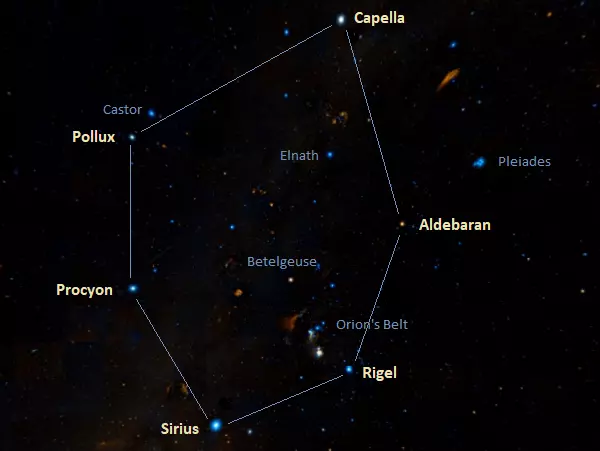
Winter Hexagon, image: Wikisky
The celestial Bull is very easy to identify because it contains two exceptionally bright open clusters, the Pleiades and the Hyades. The V-shaped Hyades cluster marks the Bull’s head and the Pleiades, its shoulder. The constellation’s brightest star, Aldebaran (Alpha Tauri), lies in the same line of sight as the Hyades and marks one of the Bull’s eyes. The orange giant Ain (Epsilon Tauri) marks the other. Unlike Aldebaran, Ain is a member of the Hyades. Aldebaran and the Hyades can be found by following the line of Orion’s Belt in the direction of Orion’s Shield. Aldebaran is the brightest star along the imaginary line.
The Bull’s horns can be found using the V of the Bull’s head. The northern horn is marked by the blue giant Elnath (Beta Tauri), a star that appears as part of Auriga’s hexagon. The southern horn is marked by Tianguan (Zeta Tauri), another class B giant. Zeta Tauri is commonly used to find the Crab Nebula (Messier 1), a bright supernova remnant in Taurus. In the opposite direction, the V of the Hyades points toward Lambda Tauri, the star that marks the Bull’s chest.
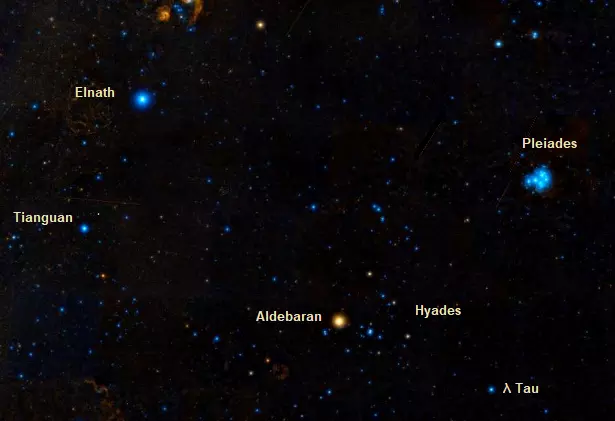
The Bull’s head and horns, image: Wikisky
Pollux and Castor (Beta and Alpha Geminorum), the brightest stars in Gemini, are found by extending a line from Rigel through Betelgeuse. The two stars mark the heads of the celestial Twins. The Twins’ feet lie in the direction of Orion. Propus (Eta Geminorum), the star at Castor’s foot, is used to find the bright open cluster Messier 35 and the supernova remnant IC 443 (the Jellyfish Nebula) in Gemini, and the Monkey Head Nebula in Orion.
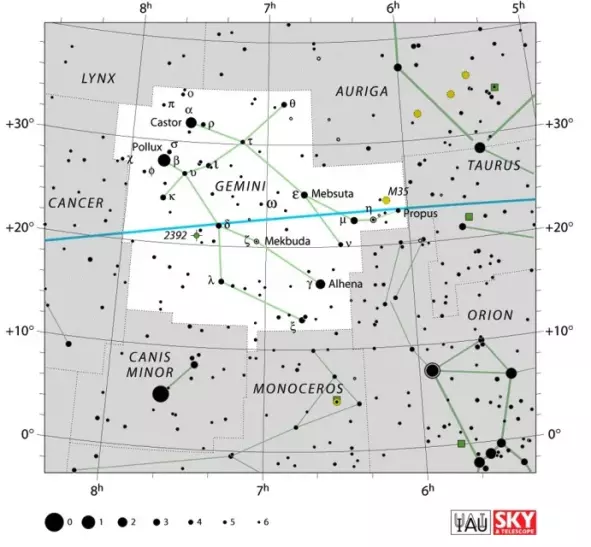
Gemini constellation map by IAU and Sky&Telescope magazine
The best time of year to see Taurus and Gemini in the evening is during the winter months. Taurus is best seen in January and Gemini in February.
Cancer, Leo and Virgo
The spring zodiac constellations Leo and Virgo are easily found using the bright stars of the Big Dipper and the constellation Cancer can be identified using the Sickle of Leo, Castor and Pollux in Gemini, and Procyon in Canis Minor.
The brightest parts of Leo and Virgo appear as a backwards question mark and the letter Y respectively. Known as the Sickle of Leo, the question mark outlines the head and mane of the Lion. Regulus, the brightest star in Leo, marks the base of the Sickle and the heart of the Lion and the bright Denebola marks the Lion’s tail. Regulus can be found using Megrez and Phecda, the inner stars of the Big Dipper’s bowl. A line drawn from Megrez through Phecda points towards the Sickle.
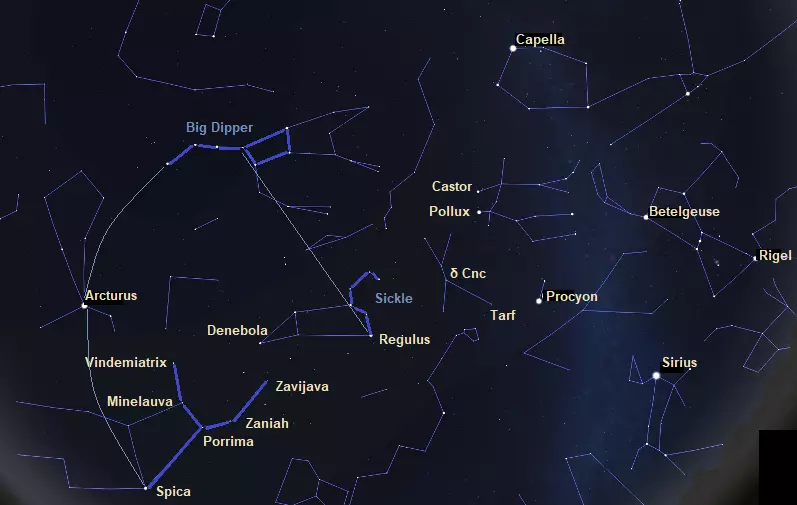
The location of Leo, Virgo and Cancer, image: Stellarium
Spica, the brightest star in Virgo, is found using the arc of the Big Dipper’s handle. Following the arc leads first to Arcturus, the brightest northern star, and then to Spica. Spica sits at the base of the Y of Virgo, an asterism that appears as the most visible part of Virgo’s constellation figure. Spica marks Virgo’s ear of grain. Porrima and Zavijava mark her left wing, Zaniah the left arm, and Vindemiatrix the right wing.
The Virgo Cluster of galaxies is found halfway between Vindemiatrix and Denebola in Leo.
The main figure of Cancer, an upside-down Y, is found between the Sickle of Leo and Gemini, just above the asterism outlining the head of Hydra. The bright open cluster M44, also known as Praesepe or the Beehive Cluster, lies near the centre of the figure and is visible without binoculars on a clear night. The brightest stars in Cancer, the orange giants Delta and Beta Cancri (Tarf and Asellus Australis), lie in the area between Epsilon Leonis, the star at the tip of the backward question mark, and Procyon in Canis Minor.
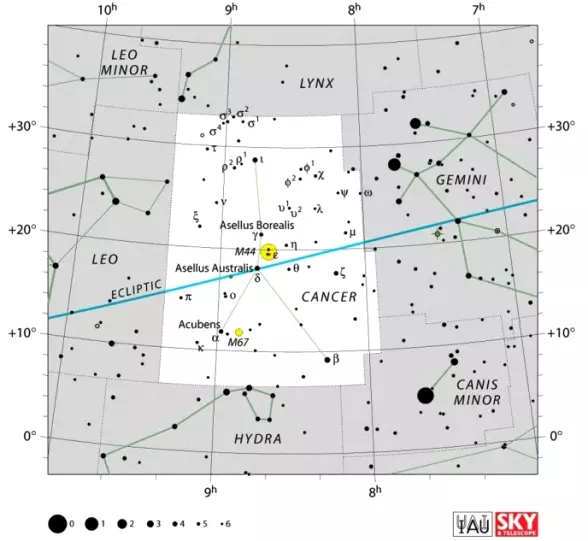
Cancer constellation map by IAU and Sky&Telescope magazine
The best time of year to observe these constellations in the evening is during the months of spring. Cancer is best seen in March, Leo in April, and Virgo in May.
Libra and Scorpius
The southern zodiac constellations Libra and Scorpius are found between the Y of Virgo and the Teapot in Sagittarius. Libra’s brightest stars, Zubeneschamali and Zubenelgenubi (Beta and Alpha Librae) appear as the extended claws of the Scorpion. The constellation itself was seen as part of Scorpius in ancient Greece and given separate status by Claudius Ptolemy, who catalogued it as Chelae (Claws) in his Almagest.
The scales asterism is formed by Zubeneschamali and Zubenelgenubi with Zubenelhakrabi (Gamma Librae), Brachium (Sigma Librae), Tau and Upsilon Librae.
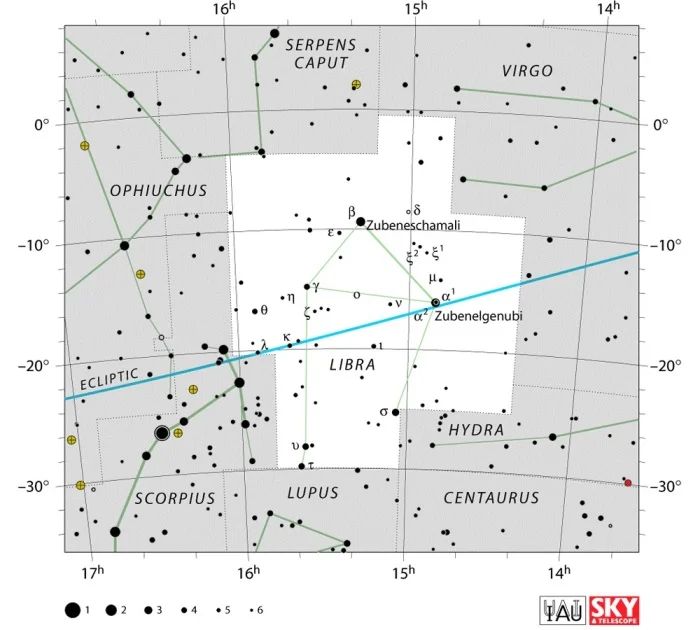
Libra constellation map by IAU and Sky&Telescope magazine
Scorpius is much easier to spot because it contains a first-magnitude star – Antares – and a more prominent asterism, the Fish Hook. The Fish Hook is formed by a curving line of stars that begins with Antares and ends with Shaula and Lesath at Scorpion’s stinger. The asterism lies between the Scorpion’s claws and the Teapot in Sagittarius.
Libra and Scorpius are best seen in the summer. The best month to observe Libra in the evening is June. For Scorpius, it is July.
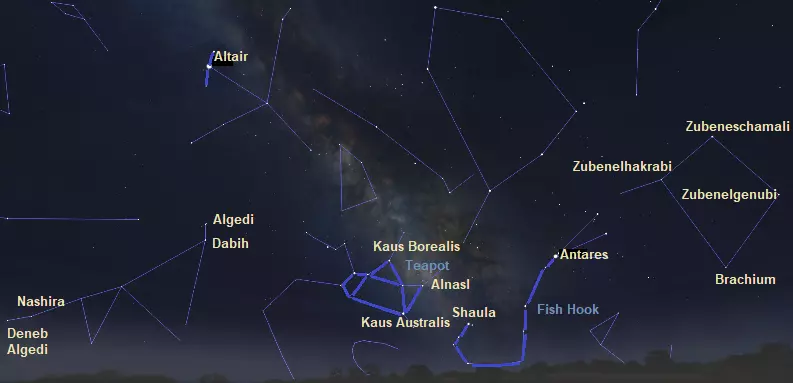
The location of Libra, Scorpius, Sagittarius and Capricornus, image: Stellarium
Sagittarius and Capricornus
Sagittarius is very easy to identify because its eight brightest stars form a prominent asterism known as the Teapot. Visible above the horizon during the northern hemisphere summer, the Teapot is located just next to a rich Milky Way field in the southern sky. Alnasl, the star at the tip of the spout, marks the Archer’s arrowhead and Kaus Borealis, Kaus Media and Kaus Australis outline the bow.
The Teapot is used as a guide for finding numerous bright deep sky objects in this region of the sky. The best-known ones include the Omega Nebula (Messier 17), Trifid Nebula (Messier 20) and Lagoon Nebula (Messier 8) in Sagittarius, and the Eagle Nebula (Messier 16) in Serpens.
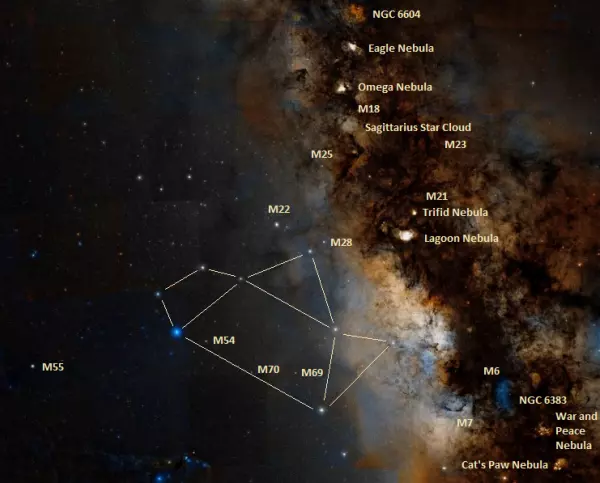
Deep sky objects near the Teapot, image: Wikisky
Capricornus is more challenging to find because it is relatively faint. It is identified by a large V-shaped figure located east of the Teapot. The right side of the V, marked by Algedi and Dabih (Alpha2 and Beta Capricorni), can be found by following the line of the Shaft of Aquila, an asterism formed by Altair with two bright stars flanking it, Tarazed and Alshain. The left side of the V begins with Deneb Algedi and Nashira (Delta and Gamma Capricorni). The tip of the V is marked by the fainter Omega Capricorni.
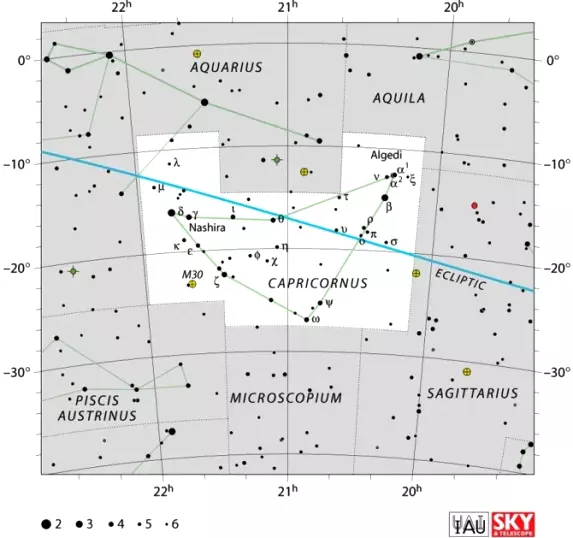
Capricornus constellation map by IAU and Sky&Telescope magazine
The best time of year to see the stars of Sagittarius and Capricornus is during the summer months. Sagittarius is best seen in August and Capricornus in September.
Aries, Pisces and Aquarius
Aries, Pisces and Aquarius can be found using the bright Square of Pegasus, an asterism that dominates the northern evening sky. Alpheratz, the top left star of the Square is the first in a line of three bright stars in Andromeda that lie between Pegasus and Perseus. Aries is found below Mirach, the central of the three stars, and below the constellation figure of Triangulum. Hamal, Sheratan and Mesarthim, the brightest stars in Aries, form a flat triangle just below the elongated triangle of Triangulum.
The triangle that forms the head of the eastern fish in Pisces lies west of the line connecting Hamal in Aries and Mirach in Andromeda. The stars that form it are faint and difficult to make out, but the base of the triangle is roughly parallel to the line connecting the two brighter Aries stars.
The head of the western fish is easier to locate because it is somewhat brighter and lies directly below the Great Square of Pegasus. The asterism that represents the head is known as the Circlet of Pisces. The heads of the eastern and western fishes are connected by cords of relatively faint stars that connect at Alrescha (Alpha Piscium). Alrescha lies near the circle of stars that represents the head of Cetus. Despite the Alpha designation, it is not the brightest star in Pisces. The constellation’s lucida, Alpherg (Eta Piscium), is part of the eastern cord. It shines at magnitude 3.61 and is not very conspicuous in the sky.
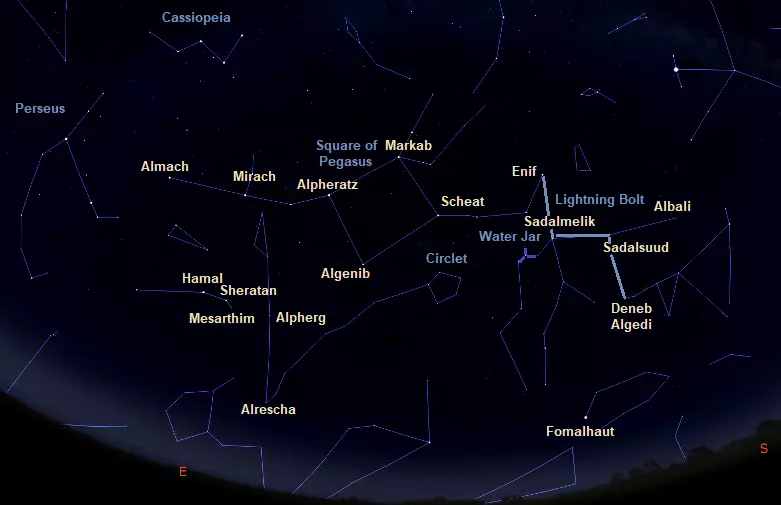
The location of Aries, Pisces and Aquarius, image: Stellarium
Aquarius is not very prominent either. The most conspicuous part of the constellation is a Y-shaped asterism called the Water Jar. It is found just below the line connecting Markab, the bottom right star of the Square of Pegasus, and Enif, the brightest star in Pegasus, which lies west of Markab and is not part of the Square asterism. The Water Jar can be used to identify the yellow supergiants Sadalsuud and Sadalmelik (Beta and Alpha Aquarii), the brightest stars in Aquarius.
Enif, Sadalsuud and Sadalmelik form an asterism known as the Lightning Bolt with Deneb Algedi, the brightest star in Capricornus. A faint curving line of stars between the Water Jar and Fomalhaut in Piscis Austrinus represents the water (or nectar) poured by the Water Bearer toward the mouth of the Southern Fish. Fomalhaut is identified as the only first-magnitude star along the imaginary line extended from Markab through Scheat (the two eastern stars of the Great Square of Pegasus).
The best time to see Aries, Pisces and Aquarius is during the autumn months. Aquarius is best seen in the evenings in October, Pisces in November, and Aries in December.
Zodiac constellations map
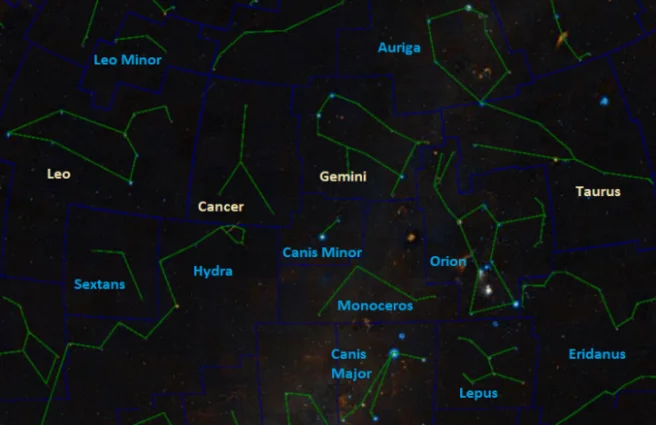
The northern zodiac constellations Leo, Cancer, Gemini, and Taurus, image: Wikisky
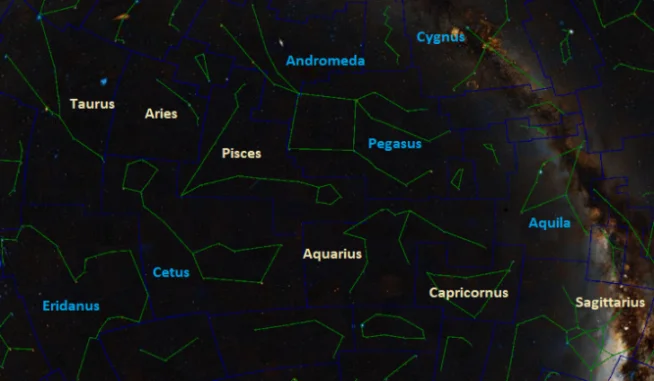
The zodiac constellations Taurus, Aries, Pisces, Aquarius, Capricornus, and Sagittarius, image: Wikisky
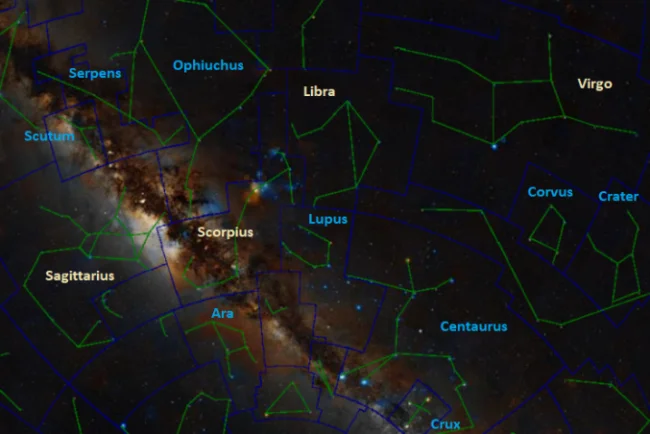
The southern zodiac constellations Sagittarius, Scorpius, Libra, and Virgo, image: Wikisky